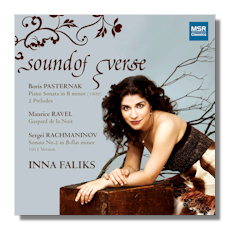
The Internet's Premier Classical Music Source
Related Links
-
Rachmaninoff Reviews
Ravel Reviews - Latest Reviews
- More Reviews
-
By Composer
-
Collections
DVD & Blu-ray
Books
Concert Reviews
Articles/Interviews
Software
Audio
Search Amazon
Recommended Links
Site News
 CD Review
CD Review
Sound of Verse

- Boris Pasternak:
- Piano Sonata in B minor (1909)
- 2 Preludes (1906)
- Maurice Ravel: Gaspard de la nuit
- Sergei Rachmaninoff: Piano Sonata #2 in B Flat minor, Op. 35
Inna Faliks, piano
MSR Classics MS1333 65:29
Summary for the Busy Executive: Interesting, but not essential.
The big news here are the musical works by poet and novelist Boris Pasternak, known in the West mainly as the author of Dr. Zhivago. Pasternak was 16 when he wrote the preludes, 19 when he wrote the sonata. All three pieces show Pasternak's considerable skills as a pianist as well as the influence of Alexander Scriabin. Pasternak had enough potential to study at the Moscow Conservatory but dropped out after six years because he felt he lacked sufficient talent and skill. As consolation prize, he became one of Russia's greatest poets.
Judging on the works here, I believe Pasternak made the right choice. The scores are remarkable for a teen, but hopelessly amateur. The preludes simply have little thematic interest. The sonata opens with arresting textures and atmosphere, but Pasternak can't keep up its twelve minutes without falling into wool-gathering. The comparison to Scriabin doesn't help. Scriabin's shapes time surely and acutely, even though he eschews traditional forms. Pasternak simply goes on and on.
A masterpiece of the Twentieth Century, Maurice Ravel's Gaspard de la nuit aims to provide the ultimate technical challenge to piano virtuosi. At the same time, however, the technical challenges pale next to the interpretive ones. Each of its three movements – "Ondine," "Le Gibet," and "Scarbo" – rests on a prose poem by Aloysius Bertrand. You can follow the music without knowing the poems, but such knowledge reveals the emotional intention and narrative flow of the music. Indeed, Ravel ties music and poem together to an astonishing degree, while at the same time inventing one unprecedented piano texture after another.
The "sound of verse" metaphor gets stretched to the breaking point with the inclusion of Rachmaninoff's Second Piano Sonata. In her liner notes, Faliks tries to tie the music to the composer's cantata The Bells and Edgar Allan Poe – unsuccessfully, in my opinion. The problem comes down to the fact that the Sonata isn't particularly inspired, as The Bells and the piano concerti certainly are. The Sonata appeared in 1913. In the Thirties, Rachmaninoff cut it down, eliminating what he deemed superfluous passages as well as pruning textures from super-dense to almost-too-dense. For a while, most pianists used the revision. Horowitz, I believe, cut the revision even further. Lately, however, pianists have brought back the original. This has shown to me no real difference in the sonata's general impression on a listener. Sure, the revision's shorter, but its new terseness doesn't overcome the lack of strong thematic interest. Long stretches still just go by without registering deeply. In other words, there's no real aesthetic advantage either to the original or to the revision – six of one, etc.
The program somewhat undermines Faliks, a fine pianist. The Pasternak, although of undoubted historical interest, hasn't the invention to stick in the memory. Faliks meets the considerable technical challenges of the Ravel, with an elegant, slightly remote account. I prefer Barbara Nissman's reading (Pierian 43), almost physically vivid. You can feel the spray of water in "Ondine," smell the reek of the hanged man in "Le Gibet," and flinch at the sudden scamperings of the imp. I consider Van Cliburn's reading of the Rachmaninoff sonata the most convincing I've heard – indeed, the only such reading (available on RCA and on Philips "Great Pianists of the 20th Century" series). On the other hand, I'd like to get a fuller sense of Faliks's playing by hearing her in other repertoire.
Copyright © 2013, Steve Schwartz


















